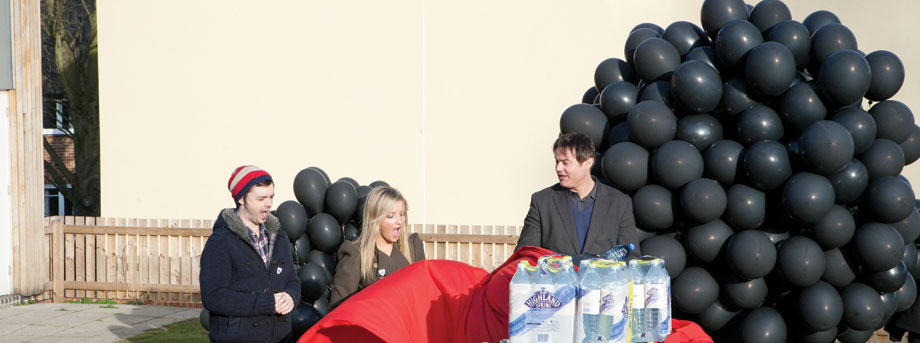Blue Peter’s big green sleepover
April 6th, 2011
As part of their Climate Week coverage – during the week the University was running its Go Greener Week – BBC Blue Peter presenters Helen Skelton and Barney Harwood spent a night in an eco-home on campus.
Together with Barney the dog, the pair spent 24 hours in the E.ON 2016 research house, part of the Creative Energy Homes Project led by the Department of Architecture and Built Environment. The house – a re-creation of a 1930s’ semi – is being used to trial energy retrofit solutions aimed at reducing the carbon impact of the UK’s existing housing stock.
As part of a research project funded by the Engineering and Physical Sciences Research Council (EPSRC) and E.ON, the house is equipped with a hi-tech real-time location energy and occupancy monitoring system. It found out exactly how much energy Helen, Barney and Barney used and how much they wasted.
Helen said: “The point of all this is to show kids how much energy we use and to make them think about what they can do to off-set that. Before I did this I thought I was so carbon neutral. But having to stop and think about what I was doing has made me really think about how good I am at conserving energy.”
Dr Mark Gillott, co-director of the University’s Institute of Sustainable Energy Technology, told the presenters to live as normally as they could. During their stay, the monitoring systems registered where they were, how much energy they were using and how they were using it. It also monitored how warm they kept the house and the amount of water they used and wasted.
A breakdown of the results would tell them what their energy consumption was for lighting, heating, cooking and appliances, right down to the TV and games console they were using. Armed with this information, experts at the University were able to calculate the pair’s total energy carbon footprint for the 24-hour period. Their CO2 production for an hour was illustrated with black party balloons. The quantity of CO2 they produced from poor energy use, such as leaving the lights on or over-filling the kettle was also shown.
Dr Gillott said: “The unique energy and occupancy monitoring system we have in the house can see where people are at any time of the day or night and what their energy consumption is. It gives a real feel for who is using the energy and how and where they are using it. In everyday life it’s hard for people to quantify their energy use and visualise CO2 emissions so to reach out to a younger audience we had to find a way of representing the CO2 emissions from our living lab during the monitoring period.
“Over one year, a typical home in the UK is responsible for the production of enough CO2 to fill a much larger hot-air balloon, and when you consider there are 26 million homes in the UK, then that’s a staggering 26 million hot-air balloons worth of CO2 produced from housing alone!”
The aim of the Blue Peter visit was to also give young viewers an idea of where savings can be made and how important it is that everyone should do their bit to conserve energy.
The results were shown on Blue Peter on Monday March 21. You can find out by watching the video online at www.nottingham.ac.uk/exchange.
And check out May’s edition of Exchange for a round-up of the University’s Go Greener Week and environmental improvements over the
past 12 months.
Tags: BBC Blue Peter, carbon footprint, Climate Week, Co2, Creative Energy Homes Project, Department of Architecture and Built Environment, Dr Mark Gillott, E.ON 2016 research house, eco-home, Engineering and Physical Sciences Research Council (EPSRC), Go Greener Week, Institute of Sustainable Energy Technology
Leave a Reply
Other News

Need news? See you on SharePoint
After 14 years of service, Campus News is being retired as the university’s staff news platform. […]

Roads and car parks closed for refurbishing work
As part of ongoing road improvements at the university, works will be taking place to resurface […]


